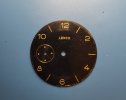Hi!
So I'm not an engraver - my passion is watchmaking.
But a conundrum just came up and I'm hoping for some help (my usual watch forums produced nothing!)
I recently bought a WW2 wrist watch, that was almost certainly a hand-made conversion of a pocket-watch movement.
The photo of the watch I used to make the purchase, showed yellow/gold printing on a black background.

However, when I dismantled the watch, I found something completely different.
It appears the original brass blank was enameled in black, and then the details were engraved, with the brass shining through.
It looks incredible!
My questions are:
Have you seen this before? (I've seen engraved watch faces filled in with coloured enamel)
How was it done? By hand, photolithography, or some kind of a jig?
How can I recreate this?
Thank you engraving community!
Here is a photo of just the dial....

So I'm not an engraver - my passion is watchmaking.
But a conundrum just came up and I'm hoping for some help (my usual watch forums produced nothing!)
I recently bought a WW2 wrist watch, that was almost certainly a hand-made conversion of a pocket-watch movement.
The photo of the watch I used to make the purchase, showed yellow/gold printing on a black background.

However, when I dismantled the watch, I found something completely different.
It appears the original brass blank was enameled in black, and then the details were engraved, with the brass shining through.
It looks incredible!
My questions are:
Have you seen this before? (I've seen engraved watch faces filled in with coloured enamel)
How was it done? By hand, photolithography, or some kind of a jig?
How can I recreate this?
Thank you engraving community!
Here is a photo of just the dial....







